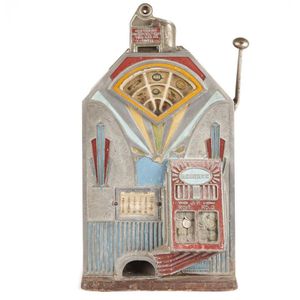Mahogany Snap Top Supper Table with Baluster Column Legs
You must be a subscriber, and be logged in to view price and dealer details.
Subscribe Now to view actual auction price for this item
When you subscribe, you have the option of setting the currency in which to display prices to $Au, $US, $NZ or Stg.
- Mahogany - Mahogany is a dense, close grained red-coloured timber from the West Indies and Central America. It was first imported into Europe in the the early 18th century and its use continued through the 19th century. It was popular for furniture making because of its strength, the wide boards available, the distinctive grain on some boards, termed flame mahogany and the rich warm colour of the timber when it was polished.. The "flame" was produced where a limb grew out from the trunk of the tree, and this timber was usually sliced into veneers for feature panels on doors, backs and cornices.
Some terms used to describe mahogany relate to the country from which it originally came, such as "Cuban" mahogany, "Honduras" mahogany etc. However unless the wood has been tested the names assigned are more a selling feature, rather than a true indication of the timber's origin. - Baluster (furniture) - An architectural term for a column in a balustrade or staircase, often defined as a "vase shape". The shape is extensively used in furniture and decorative arts.
In furniture, it is used to describe a chair or table leg turned in that form, or more usually as an inverted baluster, with the bulbous section to the top. Less commonly used to describe a chair back that has the outline of a baluster. A baluster may also be split and applied to the front of a cupboard for ornamentation.
For ceramics and silver items it is often used to describe the shape of the whole item, rather than a part.
In Georgian glassware, the shape is commonly seen in the stem of glasses. - George Iii - George III (1738 - 1820) was King of Great Britain and Ireland from 1760 to 1820.
- Scroll Legs - are in the form of an elongated scroll or 's' shape, from which the cabriole leg also derived. Scroll legs, however, are usually rather more substantial and are frequently found supporting side tables and hall tables throughout much of the 19th century. As a rule, the back legs of such tables intended to remain against the wall were flat and rectangular.
- Column - An architectural feature sometimes used for decorative effect and sometimes as part of the supporting construction. Columns should generally taper slightly towards the top. They may be plain or decorated with carving, fluting or reeding. Columns may be fully rounded or, more commonly, half-rounded and attached with glue, screws or pins to the outer stiles of doors, or the facing uprights on cabinets and bureaux.
This item has been included into following indexes:
Visually similar items

Australian World War I service medal belonging to Frederick Payne 8th Australian Light Horse who died at 'The Neck' Gallipoli on the 8th of August 1915, accompanied by a facsimile archive history of Trooper Payne

An accessories pouch by Louis Vuitton, styled in mandarin Epi leather with gold metal hardware, 14 x 24 x 2 cm.

Pair of Hans Hayson bedside tables. C. 1960s teak

A 1920s vintage American 'little Duke' one armed bandit fruit machine 19A, cast metal with painted stylish decoration stamped number 20198 (needs attention). Height 63 cm
